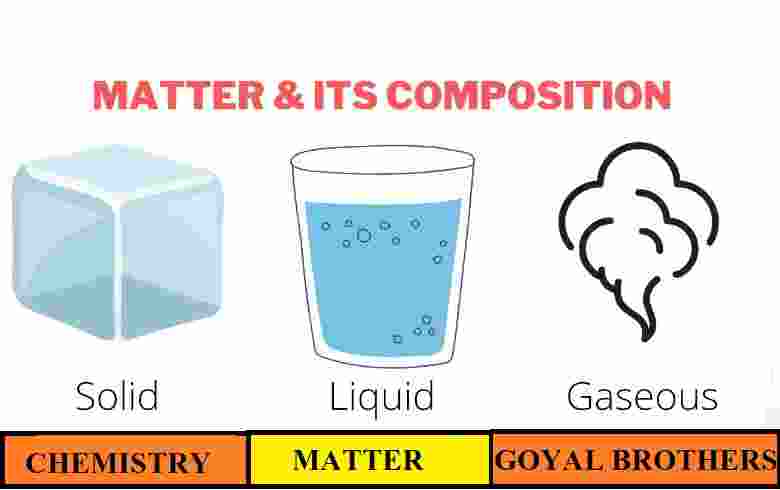Matter and its Composition Class-7th Goyal Brothers Chemistry Solutions Chapter-1. We Provide Step by Step Answers of Objective, True False , Fill in the blanks, Match the following , Study Questions of Chapter- 1, Matter and its Composition. Visit official Website CISCE for detail information about ICSE Board Class-7.
Matter and its Composition Class-7th Goyal Brothers
Chemistry Solutions Chapter-1
| Board | ICSE |
| Class | 7th |
| Subject | Chemistry |
| Book Name | Goyal Brothers |
| Theme-1 | Matter and its Composition |
| Unit-1 | Matter and its Composition |
| Topic | Solution of exercise questions |
| Session | 2023-24 |
In this article you can get the answer of these topics such as What is matter and its composition , What are the four types of composition of matter? What are some examples of composition of matter?

OBJECTIVE TYPE QUESTIONS
Chemistry Solutions Chapter-1
A. Fill in the blanks :
- Liquids can have _one_ free surface.
- Solids are _incompressible_.
- Gases have neither definite _volume_ nor definite shape.
- _Plasma_ state of matter consists of electrically charged particles of gaseous matter.
- Intermolecular _spaces_ in case of liquid molecules are large as compared to solids.
B. Statement given below are incorrect. write the correct correct statement:
1. A liquid can have any number of free surfaces
Correct Statement: A liquid have only one free surface.
2. Liquids can flow whereas gases can be heaped.
Correct Statement: Liquids can flow whereas solids can be heaped.
3. In case of gas intermolecular spaces are very small.
Correct Statement: In case of gas intermolecular spaces are very high.
4. The smallest intermolecular spaces are in case of liquids.
Correct Statement: The smallest intermolecular spaces are in case of solids.
5. The solids are fairly compressible.
Correct Statement: The solids are incompressible.
C. Match the statement in Column A with those in Column B:
Column A |
Column B |
1. Force of attraction between the molecules of matter. |
(a) Matter |
2. Spaces in between the molecules of matter. |
(b) Solid |
3. Any material which occupies space and has mass. |
(c) liquid |
4. A state of matter which is incompressible. |
(d) Intermolecular force |
5. A state of matter which can have any number of free surfaces. |
(e) Intermolecular space |
Answer:
Column A |
Column B |
1. Force of attraction between the molecules of matter. |
(e) Intermolecular force |
2. Spaces in between the molecules of matter. |
(d) Intermolecular space |
3. Any material which occupies space and has mass. |
(a) Matter |
4. A state of matter which is incompressible. |
(c) Liquid |
5. A state of matter which can have any number of free surfaces. |
(b) Solid |
D. Write ‘True’ or ‘False’ for the following statements :
- The largest intermolecular space are in case of gases. [T]
- A gas has a definite shape and definite volume. [F]
- A liquid has a definite volume, but no definite shape. [T]
- Gases are highly compressible. [T]
- The intermolecular forces are smallest in case of gases. [T]
E. Tick (√) the most appropriate answer.
1. Solids have :
(a) infinite free surfaces
(b) two free surfaces
(c) only one free surfaces
(d) no free surfaces
Ans: (a) infinite free surfaces
2. Liquids have :
(a) definite volume, but no definite shape
(b) definite shape, but no definite volume
(c) definite shape and definite volume
(d) neither definite shape nor definite volume
Ans: (a) definite volume, but no definite shape
3. The state of matter which can be easily compressed is :
(a) liquid
(c) gas
(d) (a) and (b) both
Ans: (c) gas
4. Intermolecular forces are weakest in case of :
(a) solids
(b) liquids
(c) gases
(d) plasma
Ans: (c) gases
5. Intermolecular spaces are maximum in case of :
(a) gold
(b) water
(c) honey
(d) air
Ans: (d) air
STUDY QUESTIONS
Chemistry Solutions Chapter-1
Question 1. Define the following :
(a) Element: An element is a pure substance that cannot be broken down by any physical or chemical means into simpler substances.
(b) Atom: An atom is the smallest unit of an element.
(c) Molecules: A group of two or more than two atoms of the same or different elements that are chemically bonded together is called a molecule.
(d) Matter: The term matter refers to anything that occupies space and has mass.
Question 2.
(a) What is meant by solid?
Answer: Solid is the state in which matter has a fixed volume and shape.
(b) State five characteristics of a solid
Answer: Five characteristics of a solid are
- definite shape.
- definite volume.
- there is strong intermolecular forces.
- very less intermolecular space.
- Solids are known to have high density.
(c) On the basis of molecular theory, explain why a solid cannot flow but can be heaped.
Answer: Solid has high forces of attraction between their particles therefore they have very less space between them. They do not move but they vibrate. Therefore solids can’t flow they can be heaped.
Question 3.
(a) What do you understand by a liquid ?
Answer: Liquid is the state in which matter adapts to the shape of its container but varies only slightly in volume
(b) State five characteristics of a liquid ?
Answer: Five characteristics of a liquid are :-
- No definite shape (takes the shape of its container).
- Has definite volume.
- Particles are free to move over each other, but are still attracted to each other.
- Liquid cannot be compressed much
- The intermolecular forces of attraction are weaker than solids.
(c) On the basis of molecular theory, explain why a liquid can flow and it needs a vessel to contain.
Answer: The molecules in a liquid have more kinetic energy and more intermolecular spaces as compared to solids. Thus, molecules can change their positions within the liquid. So, liquids have definite volume, but not definite shape. They can flow and always take the shape of the containing vessel.
Question 4.
(a) What do you meant by Gas ?
Answer: Gas is the state in which matter expands to occupy the volume and shape of its container
(b) State five characteristics of a gas
Answer: Five characteristics of a gases are :-
- no definite shape
- no definite volume
- high intermolecular space
- least intermolecular force of attraction.
- Gases are fluid, and flow easily.
(c) On the basis of molecular theory, explain why a gas fills entire space available to it.
Answer:Gasses fill up the space available to them because gases don’t have definite size, shape and boundary due to less attractive forces between particles. Random motion of their particles exerts pressure in all directions, and occupy any space available to them.
Question 8. Compare the characteristics of a solid, a liquid and a gas with respect to
(a) Intermolecular spaces
(b) Intermolecular forces
(c) number of free surfaces
(d) compressibility
Answer:
| Basis of comparison | SOLID | LIQUID | GAS |
|---|---|---|---|
Intermolecular spaces |
Solids have very less intermolecular spaces | Liquids have small intermolecular spaces, which is more than the solid | Gases have very large intermolecular spaces. |
Intermolecular forces |
Solids have very strong Intermolecular forces of attraction. | Liquids have less Intermolecular forces of attraction than the solids | Gases have negligible Intermolecular forces of attraction. |
number of free surfaces |
solids have infinite number of free surfaces | Liquids have only one free surfaces | Gases have no free surfaces |
compressibility |
Solids cannot be compressed. | Liquids can be very slightly compressed | Gases can be easily compressed. |
— : end of Matter and its Composition Class-7th Goyal Brothers Chemistry Solutions Ch-1 :–-
Return to – ICSE Class -7 Goyal Brothers Chemistry Solutions
Thanks
Please share with your friends if you find it useful



the 5th 6th and 7th question is missing